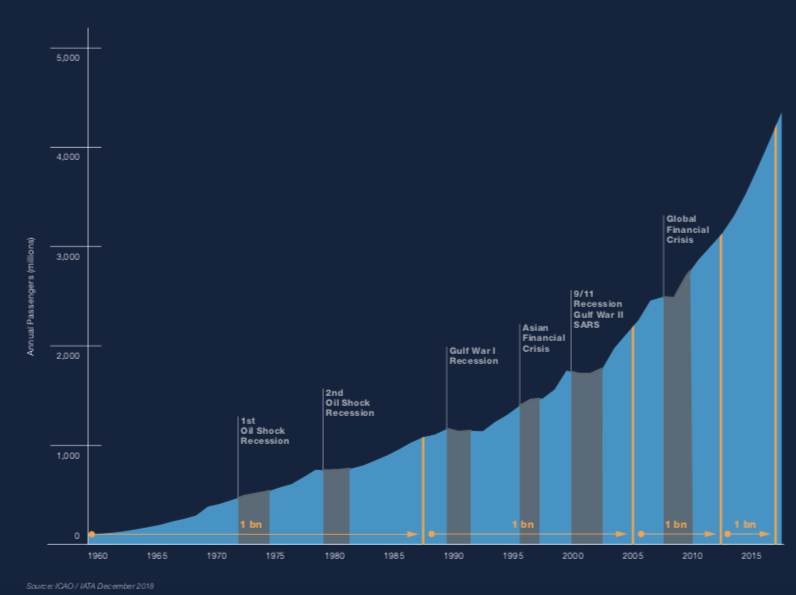Commercial aviation accounts for less than 3% of global CO2 emissions. The relatively low share of global emissions is due to the fact that only a small fraction of the global population travels by air. An estimated 80% of the world population has never set foot on an airplane and 1% of the global population accounts for 50% of emissions from commercial aviation. According to ICAO forecasts, commercial aviation will grow at 4.2% per year globally from 2018 to 2038, and above global-average growth is projected in the Middle East, Africa, and the Asia/Pacific regions. Between 2000 and 2015 air travel doubled, and – prior to the COVID-19 pandemic – the number of passenger-trips was projected to grow from 4 billion currently to over 8 billion by 2035 (IATA 2018). Pictured below is the growth in passenger-trips up to 2018. The graph reveals a resilient growth rate of ~5% with temporary declines due to economic disruptions.

Notwithstanding its low share of total emissions, air travel is not a low impact activity. Air travel can contribute a significant proportion of an individual’s or a company’s climate footprint. For example, the average European emits about 9 tons of CO2 per year. If a European takes one transatlantic round-trip economy flight, say from Frankfurt to New York, they will add a bit less than 1 metric tonne of CO2 to their climate footprint due to their share of the fossil fuel combusted by the aircraft. Aside from CO2 emissions, air travel also causes other warming effects. If these are included, such a flight adds an equivalent of 2 to 3 tonnes of CO2 to each passenger’s climate footprint.
The high relative impact of air travel has led to growing calls for people to voluntarily limit their flying, and to offset emissions from the air travel they cannot avoid. For the time being, these steps are likely to be the only practical solutions. In the future, alternative fuels and new technologies may contribute to reducing CO2 emissions, but will not eliminate them, nor can they eliminate the additional warming effects of emitting CO2 at high altitudes.
Because CO2 emissions must ultimately be eliminated to avoid dangerous climate change, choosing low-carbon alternatives to air travel such as video conferencing or train travel should be prioritized over the purchasing of carbon offset credits. The Stockholm Environment Institute’s TR2AIL project provides practical information on air travel and strategies for avoiding it.
If you still must fly, then based on current science, we recommend using a multiplier of 3 (Lee et al, 2020) to determine the number of carbon offset credits you should purchase to compensate for the full climate impact of air travel. Carbon offset purchases should be incorporated within organizational or company level strategies to achieve emission reductions. These strategies should prioritize internal reductions and supply chain or product emission reductions over carbon offset purchases.
Climate impacts from aviation
Learn how air travel contributes to climate change through CO2, Methane (CH4), Ozone (O3), and other climate forcers.
Passenger climate footprints
Passengers account for about 80% of the CO2 emissions of commercial aviation while freight accounts for the remaining 20% (ICCT, 2018). Learn about how individual passenger climate footprints are calculated, taking into account aircraft model, flight distance, seat occupancy rate, seat class, etc.
Don’t airlines already offset their GHG emissions?
Learn about the aviation sector’s Carbon Offsetting and Reduction Scheme for International Aviation (CORSIA) and the European Emissions Trading Scheme in regards to aviation.
